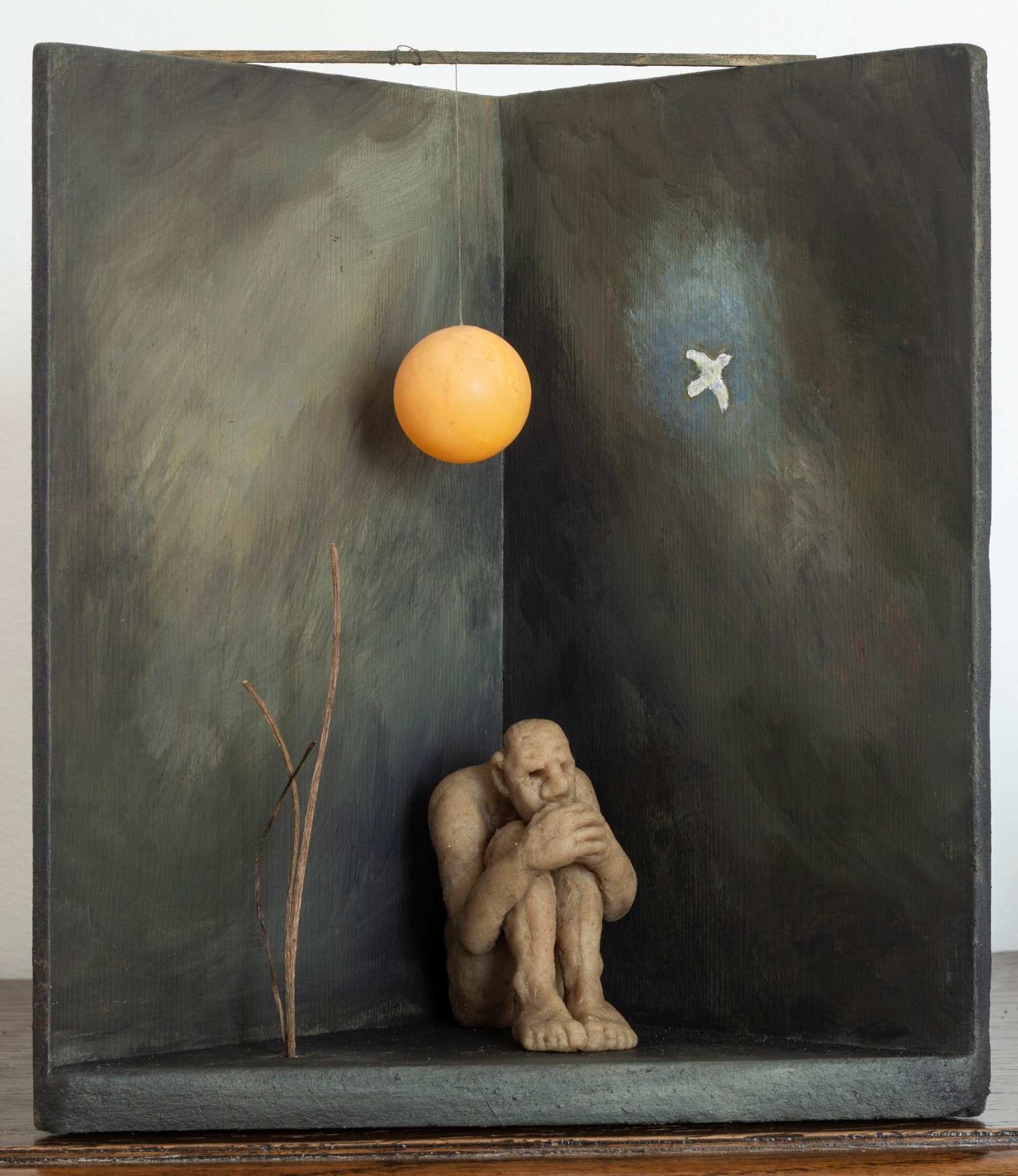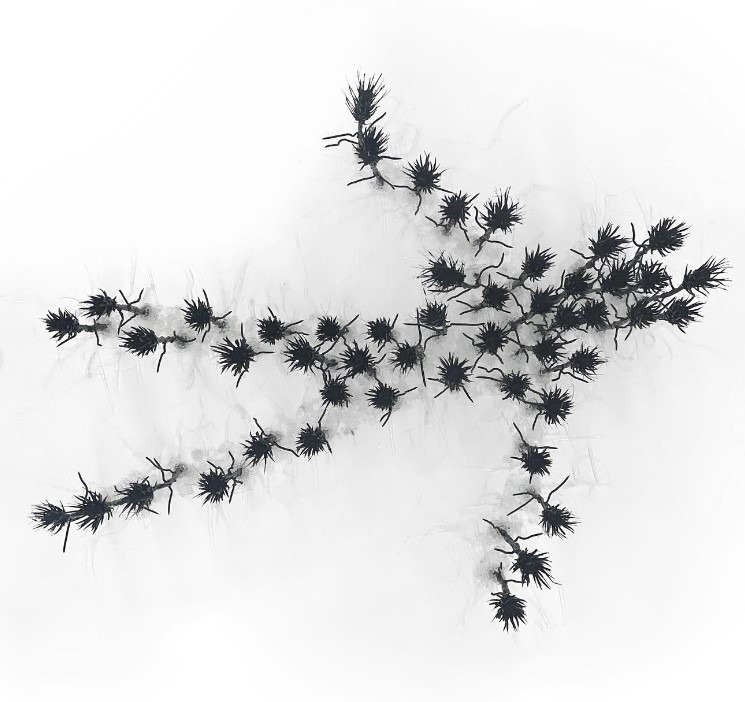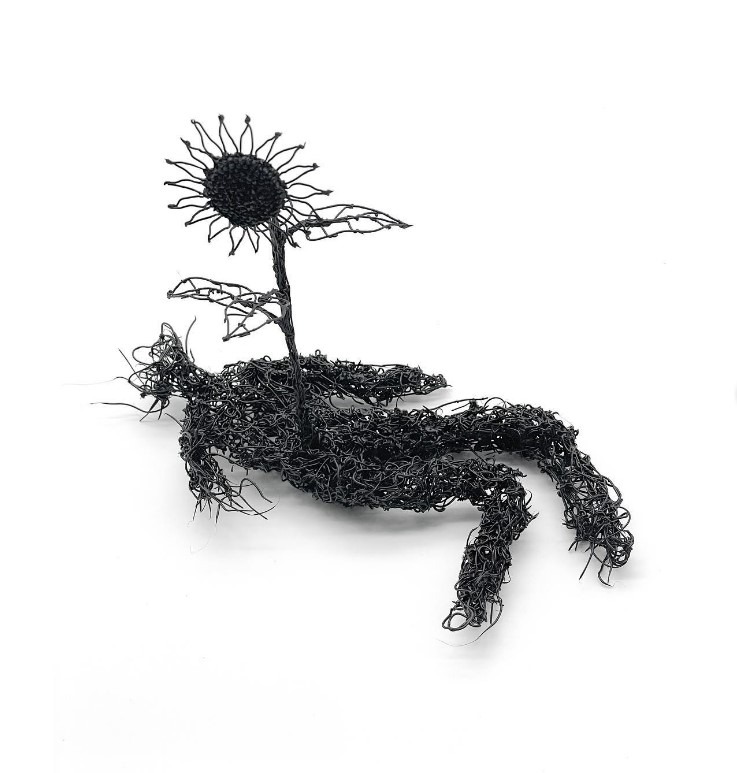
Existential Cold
Arseniy Petrov
In 2021 Pavel Otdelnov exhibited his picture “Time”, in which, on a blue background, he presented a clock with which we have been familiar since our childhood – the banner of the main Soviet television news programme [also called “Time”]. The hands are frozen a second before the beginning of the broadcast, inflicting the agony of suspense on the viewer, and drawing out the “time” for making sense of what is happening. For the generations that remember the reality of socialism, the picture clearly conveys a sense of a return to the past, or that, as it sometimes seems, that the past never went away.
In recent years it has been a commonplace for thinking people to contemplate historical time as a moment that unites the actions of society and the personality. While the authorities were reinforcing the construction of an ideology around history, and drawing a picture of the future as a return to a glorious past, books were being published and read in Russia about the societies of Nazi Germany and the Soviet Union, anticipating (though far from completely) the vector of change and attempting an awareness of the properties of the imminent reality.
On 24th February the clock hands seem to have broken free and shot backwards, propelling before our eyes, in sudden bursts, and at breakneck speed, the traumas lodged in the memory of society and of individual families and showing how we still bear, unhealed, the dreadful wounds of history. Before any profound reflexion, naturally, came the first mixed feelings: pain on behalf of the Ukrainians; a sense of shame for the state; “just like in the concentration camps, a Jew and a fascist all at once”; a feeling that one’s life and future had been stolen, when one’s personal efforts towards the creation of and integration into a humane European society had been destroyed; “as if the country had been smashed against the wall”.
It would be a mistake to reduce all these experiences to a single pattern, just as it would be to reduce the entire response of Russian art to the historic tragedy of 2022 to a single theme. One strand of the common horror is the experience of one’s absolute isolation – in the face of the Leviathan that crushes any significant protest and devours the possible leaders of political protest; in the face of those who reproach you for belonging to an aggressor state or its culture; in the face of a historical process that breaks down everything around you, leaving you with a completely insignificant field of action. To some extent this new experience is a repetition of the past. We seem to have returned to what Brodsky said: “Over this century the Russian’s lot has been such as no other people has been fated to experience (though perhaps the Chinese got even more). […] We have seen the absolutely naked, literally naked fundamentals of life. They took away our clothes and shoes, and exposed us to a colossal existential cold.”
Pavel Otdelnov. Generation. 2022. Mixed media. 210 × 250 cm
After the beginning of the war, Pavel Otdelnov created a series in which he dissected it into snow-blown elements – a typical burnt-out building in Mariupol’, the dictator, the television with its atemporal “Swan Lake”. The most important, though, are the unclothed, generalised people of a whole “Generation”, exposed to the cold and freezing, up to their chests in snowdrifts, and also the word “Future”, powdered with snow. The lifeless frozen steppes here go beyond their banal association with Russia. The ruined house has lost its residents; the multitude of people who inhabited the “aggressor country” have lost the supports for their life, their connexions, their future, the value of which is felt to the full when it is lost. The greyness that covers everything in Otdelnov’s landscapes gives the images an appearance of ordinariness, and at the same time of historical atemporality. Weather with no prospect of brightening up takes on the dimension of historical hopelessness.
Andrey Kuzkin. In the ruins. 2022

In recent exhibitions Andrey Kuzkin’s little figures moulded out of bread have appeared in the context of the group installation “Bedesmen and Heroes”. In 2022 they are being made in the same small format, but individually. In “In the Ruins”, made of broken tiles and cement found by chance, these figures are the highest expression of sorrow and pain. When he began to work with bread as a material, Kuzkin evoked the tradition of modelling in bread in Russian prisons, and eucharistic associations. It is hard to say whether this symbolism plays a part in his most recent work. Bread undoubtedly makes the rough finish convincing, and the generalised nature of the ruins allows a breadth of possible interpretations: as the victims of bombing, or as the wrecked lives of refugees and emigrants. The bareness, the lack of any covering for these modest – and for that very reason very trustworthy – figures allows an immediate experience of the misfortune that has befallen them. The series ends with “Eternal Spring in Solitary Confinement” with an absolutely minimalist mise en scène. Kuzkin’s man does not appear to have been driven into a corner, he calmly occupies his space. His surroundings do not look much like prison walls, on the contrary, they are softened by natural elements: the bare twigs of a bush, a bird, and something that might be either the sun or the moon (a ping-pong ball coloured a warm yellow). The prison walls shut him off from society, separate him from the milieu of family or friends, and Kuzkin’s “solitary confinement” is indeed close to Brodsky’s existential abandonment.
Andrey Kuzkin. Eternal Spring in Solitary Confinement. 2022
His words about existential cold end as follows: “The result of this must be enormous human suffering.” Today’s propaganda pushes the heroicisation of the “Great Victory” and its participants. As a counterbalance to this, Russian art has always lacked an interpretation of all the fallen, and all of the participants in war as victims, including the “victims of history”, as Brodsky called those who had mindlessly succumbed to propaganda in his Nobel acceptance speech. It is doubtful whether the present military aggressors may be pitied, and that certainly cannot be expected of people who live in Ukraine, but at the same time, art allows one to test one’s feelings. Thus Sergei Prokofiev has created a series of dead “invaders”. These figures show different phases of the history of a corpse, which has lost its human component and is going through an exclusively natural cycle.
Sergei Prokofiev. Invader 10. 2022
A stiffened body. A dog eating a soldier. A decomposed body. Something growing out of another body. Yet another body, no longer on the surface of the earth, we can only see its outline in the growing wheat if we look from above. Sergei Prokofiev’s technique – a 3D pen and black plastic – looks particularly effective when he photographs his work against a snow-white background. All these figures of soldiers – burnt, rotting, eaten by dogs and pigs, could be seen in documentary shots of 2022. We are trying to erase them from our memories; looking at this for any length of time is unbearable.
Sergei Prokofiev. Invader 10. 2022
Prokofiev’s images, though equally true to life, allow us to rest our gaze on them, they relieve the acuity of the moment. Translated into plastic, swallowed by the shining white background, they are perceived, as it were, from the distance of history. The dead man, even if he is an invader, is a human life stupidly destroyed, a failure of humanity. When the fanfares and propaganda speeches have faded away, there will just be bodies lying in the fields, and they will become fertiliser.
Sergei Prokofiev. Invader 7. 2022
The sunflower growing out of a soldier’s body is an immediate echo by Prokofiev of one of the main images of Anselm Kiefer. Born in 1945, he has spent all his life interpreting the German cultural tragedy of the twentieth century, on questions of history and war as a man-made catastrophe. At his exhibition in Venice in 2022, a coffin with two sunflowers inside it was placed at the centre of the key composition. It may be noticed that this is not only two modern artists echoing each other. Van Gogh’s sunflowers, which opened the way to expressionism in European painting, are full of vitality, life and hope. Kiefer’s, and his Russian contemporary’s, look like a dried-up resinous sun, and there is no longer any hope that their seeds will be good for anything.
Like they year 2022 itself, the chosen works do not leave the viewer any cause for optimism. But it is important that there are artists who raise these topics. This may be a means of reassembling Russian culture, and of overcoming the existential cold.